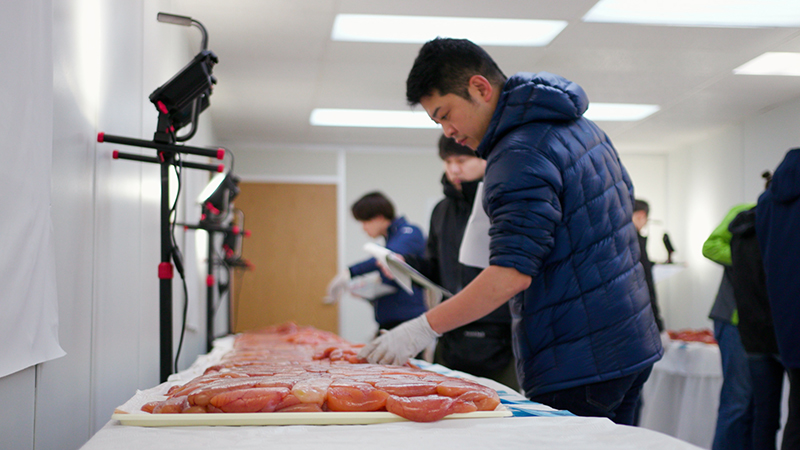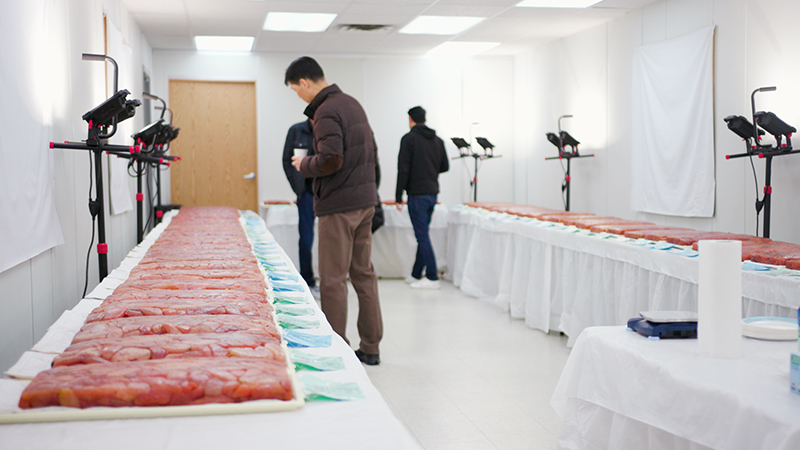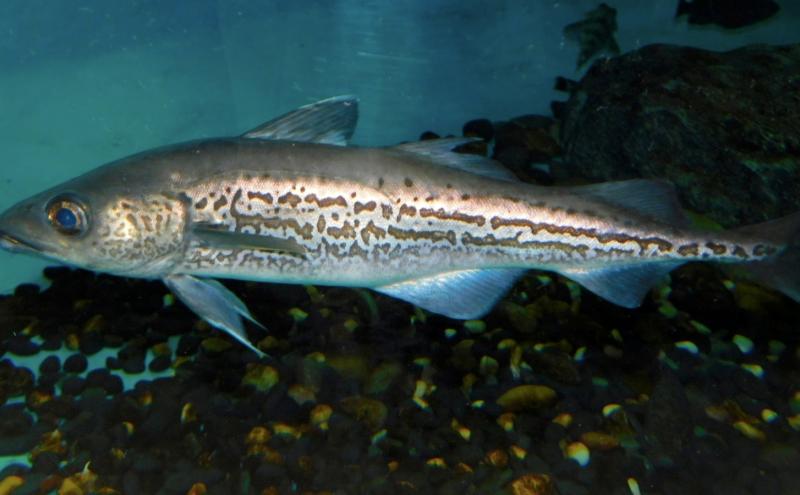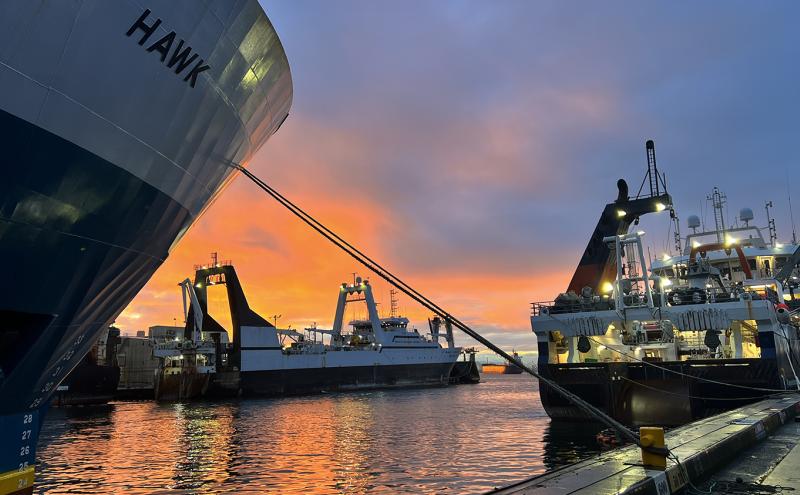Terminal 91 is known as a home port for many large commercial fishing vessels, providing services and amenities before and after journeys to sea. What is less known is that the Port of Seattle property is also the epicenter of a multi-million-dollar trade that's mostly invisible in the United States — Alaska pollock roe (eggs or caviar), a luxury item in Japanese and Korean cuisine.
From the end of January through March, the North Pacific Fishing Fleet, based at Terminal 91, heads to Alaska to fish for Wild Alaska Pollock. Most pollock is caught in the Bering Sea off Alaska and makes its way to the market as surimi, fish sticks, and frozen white fish fillets. The most valuable commodity sits in the belly of these fish. Pollock roe makes up less than five percent of the catch weight but earns about one-third of the total catch value, which means the sales are in the millions of dollars each year.
Each spring, pollock roe auctions are held at Terminal 91, drawing hundreds of buyers from Japan and Korea. The roe is unloaded from fishing vessels upon their return home from Alaska. Buyers from Japan and Korea file into trailers set up on the property by different seafood companies to examine and place bids on the high-dollar seafood product. By the end of these auctions, hundreds of millions of dollars worth of pollock roe have been sold.
Seafood companies involved in the latest auctions (some of which are Terminal 91 tenants) include Westward Seafoods, Alyeska Seafoods Inc, Coastal Alaska Premier Seafoods, Northern Victor, Trident Seafoods, Phoenix Processor Limited Partnership, Northern Hawk, Golden Alaska, American Seafoods, Arctic Storm and Glacier Fish Company.
Although the product is invisible to domestic consumers, the United States is the largest exporter of pollock roe in the world. The Terminal 91 auction is one of two major roe auctions in the world and home to the highest value pollock roe auction. (The second largest is in Busan, Korea, and features Russian pollock roe).
Allen Kimball, an executive consultant in the seafood industry, said during one (annual) series of roe auctions producers can sell 25,000 tons or 50 million pounds of roe, bringing in between $200-300 million dollars. Today the global market consumes around 50,000 tons of pollock roe a year. Russia produces the most volume with the U.S. ranking second, but U.S. roe is valued higher than roe produced in other markets.

Savor the flavor
Pollock roe is found in the belly cavity of pollock during the spawning season (January through March). As part of the production process, fishermen recover these high-value eggs that sell at auctions like the Terminal 91 auction.
In Japan and Korea, pollock roe is salted and flavored as part of a dish (commonly eaten with rice) or used as a garnish. The roe is brined and brings a sharp, salty taste to the edges of the tongue. In Japan, you can find roe in supermarkets served in onigiri rice balls, crackers, spaghetti sauce, and mayonnaise. Or order a serving of pollock roe as a side dish in a restaurant. It is also a popular ingredient in sushi and a key ingredient in a Korean hot, spicy soup.
Determining quality
During each auction, buyers and representatives inspect trays of roe, evaluating the bright red, small, lung-shaped sacs of fish eggs, which are broken down into 12-17 different grades and sizes. The grade of the roe is determined by color, size, maturity, and firmness and whether it's damage-free. Buyers also evaluate the egg sacs for firmness and condition.
Different grades have different uses and sell for different price points in the Japanese and Korean markets:
- Mature (Mako grade) undamaged roe, with natural color and its presentation of roe skein, is brined, can be flavored with spices, and is displayed in department stores as a high-end beautiful product, selling at a very high price
- Over-mature roe is boiled, cooked, and (or) dried
- Loose eggs not in the skein are used in rice balls (onigiri), pasta, or dried in crackers and pretzels
- Immature roe (Gamuko grade) has a thick skin and is primarily used in Korean soups

A journey to Seattle
Traditionally Japanese fishermen caught pollock roe in their own vessels in the Bering Sea; in 1976, the passage of the Magnuson-Stevens Act expanded U.S. jurisdiction to regulate fishing grounds 200 miles from U.S. shores, address overfishing and promote sustainable fishing, and limit unregulated foreign fleets. As foreign access diminished and the demand for roe grew in Asia, Japan began to work with U.S. producers. In the beginning, U.S. producers sold much of their fish at Japanese auctions, but eventually an idea was put in motion to test an auction for pollock roe specifically in the U.S. The auctions became very successful and continue to be the global process to determine prices for pollock roe in the world market. The first U.S. pollock roe auction was held in 1989 at Terminal 91; Seattle was a natural location because it's the home of the North Pacific Fishing Fleet, serves as the headquarters for many seafood companies, and offers easier access for buyers than Alaska.
Over time the auctions grew, with more seafood companies and buyers participating. Pollock roe reached its highest price point between 2000 and 2010 when it was sold primarily as a luxury or gift item. Since then, roe has become more normalized and easier to access, even showing up in grocery stores. There's still strong demand, but its value has diminished, with prices down significantly from 15 years ago, said Bart Lovejoy, Vice President of Global Sales at Glacier Fish Company. He said seafood companies are working to promote and create new demand for pollock roe through trade associations such as GAPP (Genuine Alaska Pollock Producers) and ASMI (the Alaska Seafood Marketing Institute); influencer marketing; food service, retail, and partnership promotions; and connecting a new generation of seafood consumers with the history of the product to draw out interest.










